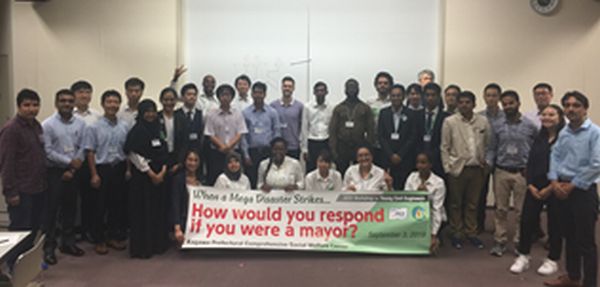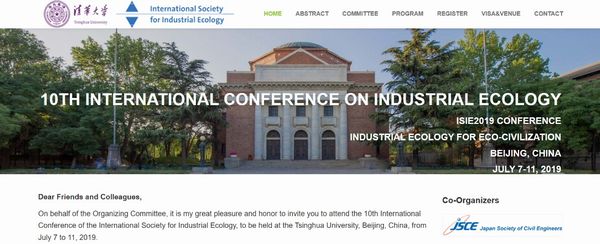IAC News
IAC News No.85, November 2019
Japan Society of Civil Engineers International Activities Center Nov. 1, 2019 IAC News No.85
2019 JSCE Annual Meeting Report
International Workshop for Young Civil Engineers

Yoshihiro Okumura
(Kansai University)
IAC International Student Network Group, IAC held the International Workshop for Young Civil Engineers, as part of the 21st International Summer Symposium, on September 3rd at Kagawa Prefectural Comprehensive Social Welfare Center. The workshop targeted the international students who were studying in Japan and the international young civil engineers who were working in Japan, under the theme of “When a Mega Disaster Strikes… - How would you respond if you were a mayor? -.” This workshop is very unique because the mayors in the Miyagi Prefecture experienced the same workshop half a year before the 2011 Great East Japan Earthquake and Tsunami. Twenty-seven participants were divided into five groups, and they played the mayor of city damaged by a mega earthquake and tsunami disaster. Each group discussed Common Operational Picture (COP) and Incident Action Plan (IAP): in what situation the city should be in a week. Then, they reported the objectives, post-disaster policies and practices like a real mayor in a pseudo-press conference.
The participants’ comments are as follows:
・Thank you very much for arranged this event which it was very interesting and useful for engineering field.
・It was very useful information and lesson learned for foreign student due to the information include how to prepare when severe disaster happens.
・I would love to join this kind of event again. I will invite my classmate or next year students to join this WS next year.
The Workshop was based on ISO 22320, which is the international standard of emergency management. The experience that the participants gained in the workshop would help them to function well in any field, in any company, in any country where they will work.

Participants at the Workshop Closing

A Mayor Reports at a Press Conference

Participants Discuss Post-Disaster Policies
【Reported by Yoshihiro Okumura, Associate Professor of
the Faculty of Sciences, Kansai University】
Activities of Committee on Environmental System

Yasuhiro Arai
(Secretary-General, Commitee on Environmental System)
1. History of the Committee on Environmental Systems
The Japan Society of Civil Engineers (JSCE) has been dealing with environmental issues for almost half a century, since the first symposium for environmental issues was held as part of the conference of the JSCE in 1972, the year of the United Nations Conference on the Human Environment. Since then, instead of focusing only on pollution problems caused by industrial activities, the JSCE has introduced equipment and social systems that intermediate between humans and the environment and established the Subcommittee on Environmental Issues within the JSCE with the aim of developing sustainable national land for the long term. As a result, various researches and initiatives have been disseminated through symposia on environmental issues and collections of symposium lectures and papers. Moreover, the Committee on Environmental Systems (first chaired by Tomitaro Sueishi) was established in 1988 and continues under the same name today. The Committee regards the natural environment as a system, based on the relationship among the natural environment, humans, and the society in which people live.
2. Workshop for Presenting Papers on Environmental Systems and Symposia
The Committee on Environmental Systems holds workshops for presenting research papers on environmental systems once a year and a symposium for environmental systems and local symposiums several times a year (Photo 1). The purpose is to organize environmental system studies and disseminate researches, proposals, and practical reports that focus on building the system infrastructure for society and the environment. The Committee addresses many issues, varying from those concerning local areas to the global environment, and approaches the researches from different perspectives, such as environmental fate, planning, maintenance, evaluation, economy, system, information, awareness, education, and ethics.
3. Various Activities of Subcommittees
While the three subcommittees that support essential activities including thesis review, awarding, and digitization play a major role in the Committee, there are also other subcommittees that deal with themes such as environmental system business development, review of research on environmental systems, globalization, health and the environment, the SDGs, and symbiotic communities with regional circulation. They together work on promoting systematic researches and outreach, and exploring new frontiers. In particular, as part of international cooperation with the International Society for Industrial Ecology (ISIE), the ISIE 6th Asia-Pacific Conference (Tsingtao, China) was held in September 2018 and the ISIE 10th International Conference (Beijing, China) was held in July 2019 co-hosted with the Committee on Environmental Systems, JSCE (Photo 2).

Photo 1 The 58th Symposium for Environmental Systems

Photo 2 The 10th International Conference on Industrial Ecology
(from official website)
【Report by Yasuhiro Arai, Secretary-General, Commitee on Environmental System】
Activities of Coastal Engineering Committee

Yoshimitsu Tajima
(Secretary-General, Coastal Engineering Committee)
1. Introduction
Coastal Engineering was founded in the United States as a branch of civil engineering in 1950s. In Japan, the first conference of Coastal Engineering was held in 1954 and the Coastal Engineering Committee (CEC) was organized as one of research-oriented committees of Japan Society of Civil Engineering (JSCE) in the following year. The CEC significantly contributed to the development of Coastal Engineering in Japan through annual Coastal Engineering Conferences and through technical supports for Coastal Law launched in 1956 and for editing and revisions of Design Manual for Coastal Facilities.
2. Recent Activities of Coastal Engineering Committee
The number of annual Coastal Engineering Conference held by the year 2019 has reached 66. This three-day conference with total participants of around 2500 consists of a symposium, a special session and around 300 oral presentations with publication of JSCE journal papers. We now have an option for authors to give an oral presentation without publishing JSCE journal paper and instead writing a journal paper for Coastal Engineering Journal in order to respond to needs of various researchers.
Coastal Engineering Journal (CEJ), formerly the journal, Coastal Engineering in Japan, launched in 1958 by the CEC, is included in the list of Science Citation Index journals. The CEJ, with the recent Impact Factor of higher than 2, is one of the the leading international journals in the coastal engineering field. Since further improving and advancing of the CEJ is one of important tasks, the CEC strongly supports the editorial board of the CEJ.
Besides annual conferences and publications of journals, the CEC now has five research-oriented sub-committees and 2 working groups to conduct various research activities in collaboration with other societies and committees. The CEC also has conducted coastal disaster surveys in various countries such as the Philippines, the United States and Bangladesh. Especially after Typhoon Haiyan in 2013 and Hurricane Irma and Maria in 2017, the CEC conducted joint surveys respectively with the survey teams of the Philippines (PICE) and the United States (ASCE). In 2018, we also conducted the disaster surveys of the storm surge and waves around the Osaka Bay induced Typhoon Jebi. The results of the survey, shown in Figure 1, were reported in the session, which is outlined on the website of the CEC and published as a survey report in the CEJ.

Figure 1 Measured Surge Hights around Osaka Bay after Typhoon Jebi
【Report by Yoshimitsu Tajima, Secretary-General, Coastal Engineering Committee】
JSCE UK Section Report
~Short Course on Railway Traffic Optimisation~
Railway Research Group of University College London ran a one-day short course on railway traffic optimisation on Friday 16 August 2019 in collaboration with Beijing Jiaotong University and Rome Tre University.
The course aimed to provide basic knowledge about the algorithms and techniques currently available for railway traffic optimisation, to railway practitioners. The motivation was that, as the rail industry goes to ‘digital’ and Traffic Management Systems are expected to act as a key enabler, practitioners who are not necessarily system engineers or programmers, but project managers, signal engineers or those in any other capacities, now need to understand basic algorithms and techniques for Traffic Management Systems as well as necessary data input/output arrangements.
The short course attracted more than 50 participants, and some practitioners are even from other countries including the USA, France and India.
【Programme】
•Introduction
•State of the Art on Railway Traffic Management
•Lecture1: Train Timetabling Using Linear Integer Programming
•Lecture2: Train Rescheduling Using Job Shop Scheduling
•Discussion and Conclusion
【Lecturers】
•Prof. Benjamin Heydecker (University College London)
•Dr. Taku Fujiyama (University College London)
•Prof. Andrea D’Ariano (Roma Tre University)
•Dr. Yihui Wang (Beijing Jiaotong University)

Prof. Benjamin Heydecker (University College London)

Dr. Taku Fujiyama (University College London)

Prof. Andrea D’Ariano (Roma Tre University)

Dr. Yihui Wang (Beijing Jiaotong University)
Updates
-
“DOBOKU Collection 2019” (November 14~17, 2019)
https://dobokore8.webnode.jp/ -
“DOBOKU DAY Symposium 2019” (November 24, 2019)
http://committees.jsce.or.jp/cprcenter/node/198 -
Up-coming Events
1. 2019 Site Excursion & Joint Company Information Session in Osaka (November 25, 2019)2. 2019 Joint Company Information Session in Tokyo (December 7, 2019)
3. 3rd Seminar on the Dissemination of Japanese Technical Standards Overseas (December 17, 2019)
http://committees.jsce.or.jp/kokusai/node/1544. Japanese Civil Engineers the Global Leaders Symposium Series No.15 (February 5, 2020)
-
jhappy - JICA’s Grant Aid Cooperation -
Facebook: https://www.facebook.com/jhappy20161110/
Twitter: https://twitter.com/jhappy_official -
The International Infrastructure Archives
– A Compilation of Japan’s Greatest Projects in Transfer of Civil Engineering Technology in Service –
http://www.jsce.or.jp/e/archive/ - Asian Civil Engineering Coordinating Council (ACECC) International Newsletter
http://www.acecc-world.org/newsletter.html
- IAC “News Pick Up!!” on the JSCE Japanese website
http://committees.jsce.or.jp/kokusai/node/138
- Summary of featured articles in JSCE Magazine Vol. 104, No.11, November 2019
http://www.jsce-int.org/pub/magazine
- Journal of JSCE
https://www.jstage.jst.go.jp/browse/journalofjsce
IAC News Subscription
The IAC News is one of the communication tools to share information and ideas with the members. We would like to invite you, your friends and colleagues to join the communication and to subscribe the IAC News. Please register online: (http://www.jsce-int.org/node/150). We look forward to meeting you.
